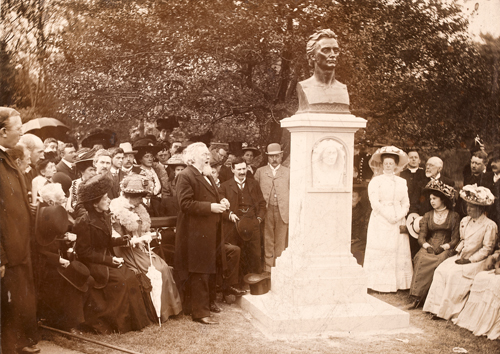Sigerson resigns from Seanad amid continued attacks on politicians’ homes
Dublin, 6 February 1923 -The esteemed scientist and writer, Dr. George Sigerson, has resigned his membership of Seanad Éireann owing to threats to burn his house and property.
Dr. Sigerson, who has forwarded his resignation to President W. T. Cosgrave, told a reporter that his only reason for doing so was that he had ‘received a letter threatening incendiarism - to burn down my house and property - and, consequently, as I did not want my patients to be disturbed or injured I resigned my position as Senator. There is absolutely no other reason for the action I have taken.’
Dr Sigerson added that he ‘did not mind the threats of a shooting and attended the meeting of the House, as was my duty, but this thing of burning down my house is another matter, and I felt I had no alternative but to resign, having regard to my family and their property.’
The author of numerous books on medical topics and on Irish historical subjects, Dr. Sigerson is a former President of the Irish National Literary Society and is currently Professor of Biology at the National University having previously been connected to the old Catholic University Medical School. Dr. Sigerson was one of 30 Senators nominated by President Cosgrave and had the distinction of being elected temporary chairman at the historic opening sitting of the second house.
Dr. Sigerson’s resignation follows a series of attacks by so-called Irregulars on politicians’ homes, including the complete destruction last month of the Rathfarnham residence of President Cosgrave.
Pathé footage of President Cosgrave visiting his burned-out home at Rathfarnham. Ireland in January 1923 - now the Pathé offices in Dublin have been the focus of arson attack.
Later in January, Temple Hill House, the residence in Kimmage, Co. Dublin, of former Irish Party MP, Mr. Stephen Gwynn was attacked by a landmine, which was exploded in the hall. Sir Horace Plunkett’s beautiful mansion, ‘Kilteragh’, was also completely destroyed, along with its many priceless contents. The mansion in Foxrock housed paintings, china and a library collection that had been amassed over many decades.
Outside of Dublin, in Co. Cork, the residence of Farmers’ Party TD, Mr. John Dineen, was also set ablaze. The house is situated at Clonmult, Midleton. Recently, a man in Dublin was kidnapped when he was mistaken for Mr. Dineen, who is a TD for East Cork.
The attacks continued in February with an attempt to burn down a restaurant on Henry Street that is owned by Senator Jenny Wyse Power. Due to those inside the restaurant quickly quenching most of the flames with a carpet and to the speed of response from the Fire Brigade at Tara Street, the damage was kept to a minimum. Mrs. Wyse Power was not present at the time of the attack, but was getting off a tram car at Nelson’s Pillar just as the Fire Brigade was arriving on the scene.
On December 10th last, the same night as Capt. Seán McGarry’s home was set alight, Mrs. Wyse Power’s produce store on Camden Street was also attacked, a bomb was hurled through the window, causing major damage to the stock.
Also targeted in recent attacks was the Dublin office of the Pathe Freres, the well known cinematograph film producers, with offices at the corner of Lower Abbey Street and Sackville Street, near to O’Connell Bridge. The building is relatively new having been erected to fill the site of a building previously destroyed during the 1916 Rising. The estimated cost of the damage has been put at £20,000. The offices and showrooms were destroyed on the first and second floors of the building and lost too was more than 1m feet of new films, as well as cinematograph machines and other valuable equipment.
It is being speculated that the premises were attacked owing to the recent exhibition in Irish pictures houses of film from the firm showing the new Irish air force at work, as well as scenes of the devastation wrought upon fine Irish mansions. It was shortly after the Pathe Freres offices opened for business that four armed men entered the building and ordered five staff members - one man and four women - into one of the rooms telling them not to move. The raiders proceeded to walk through the building sprinkling petrol before setting the building alight. The staff members, on smelling the smoke, made a dash for the street, several of them sustaining burns as they escaped.
[Editor's note: This is an article from Century Ireland, a fortnightly online newspaper, written from the perspective of a journalist 100 years ago, based on news reports of the time.]





















